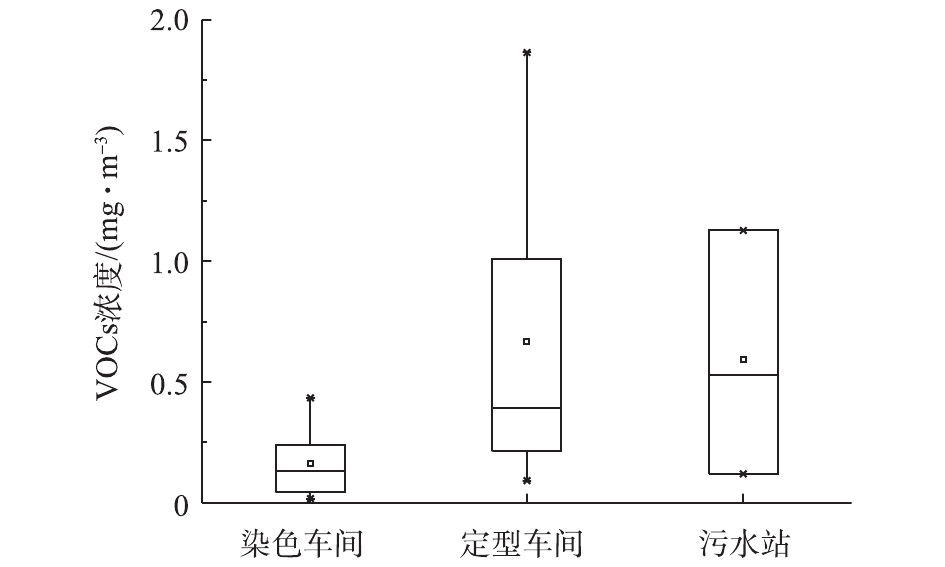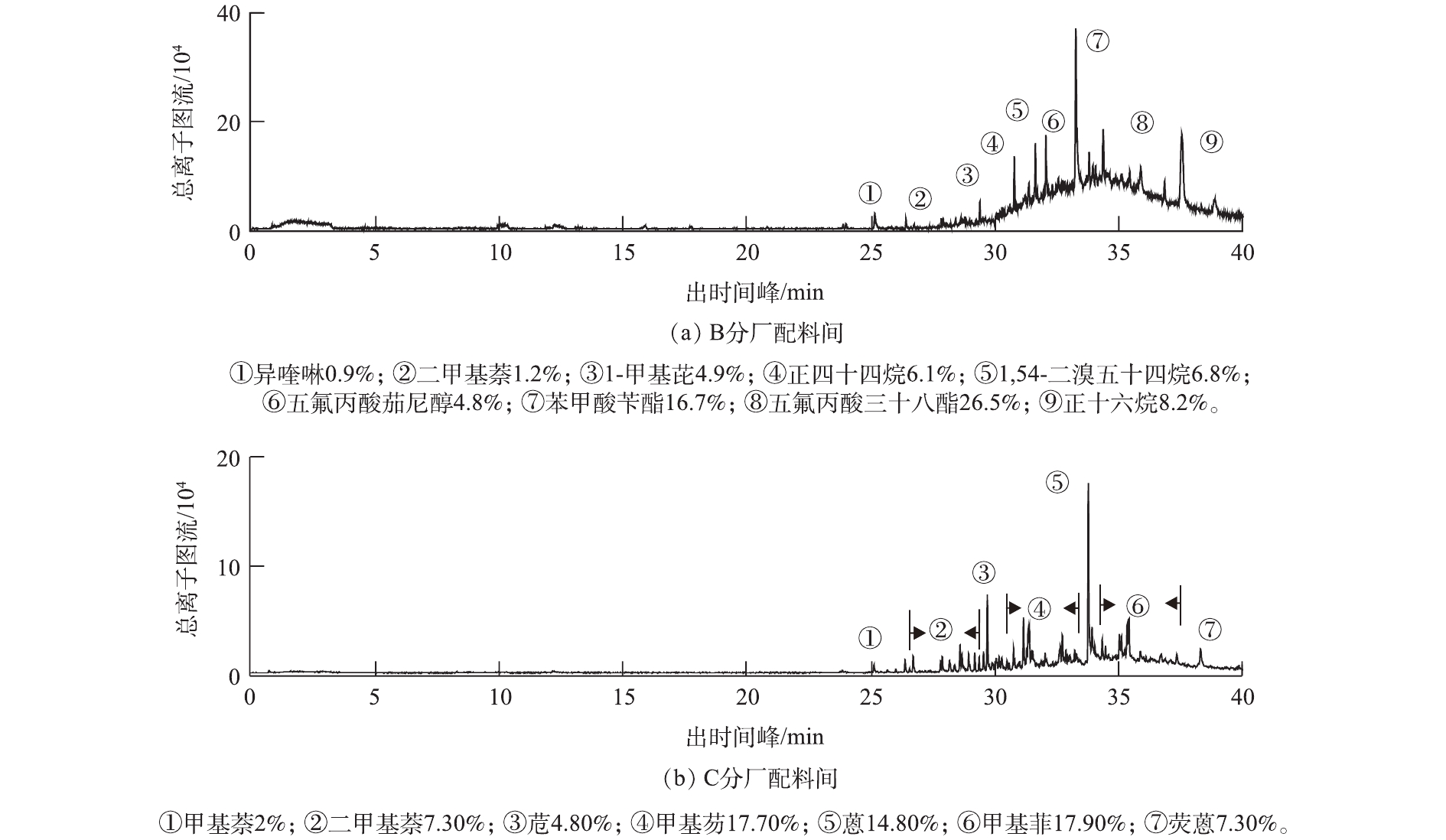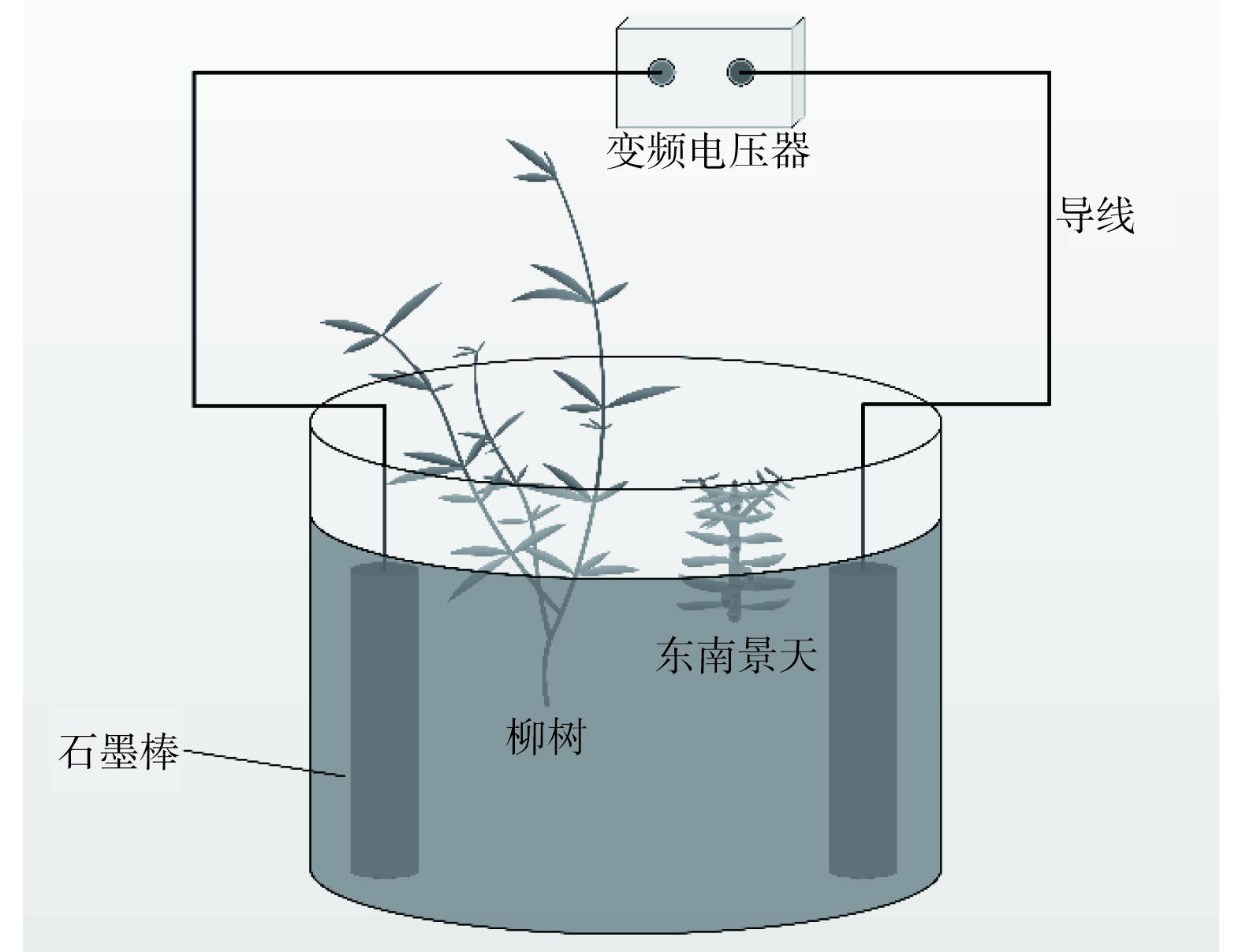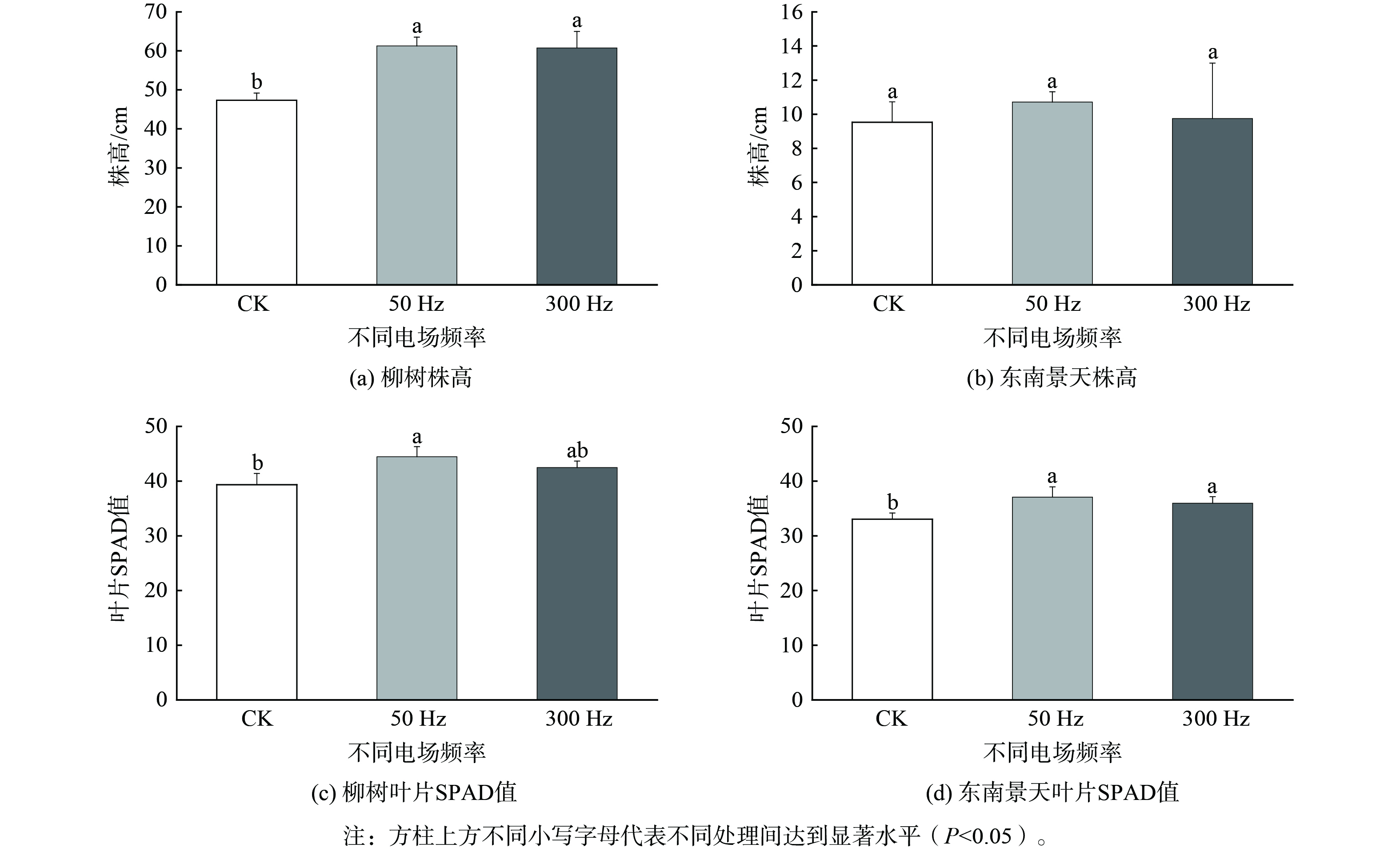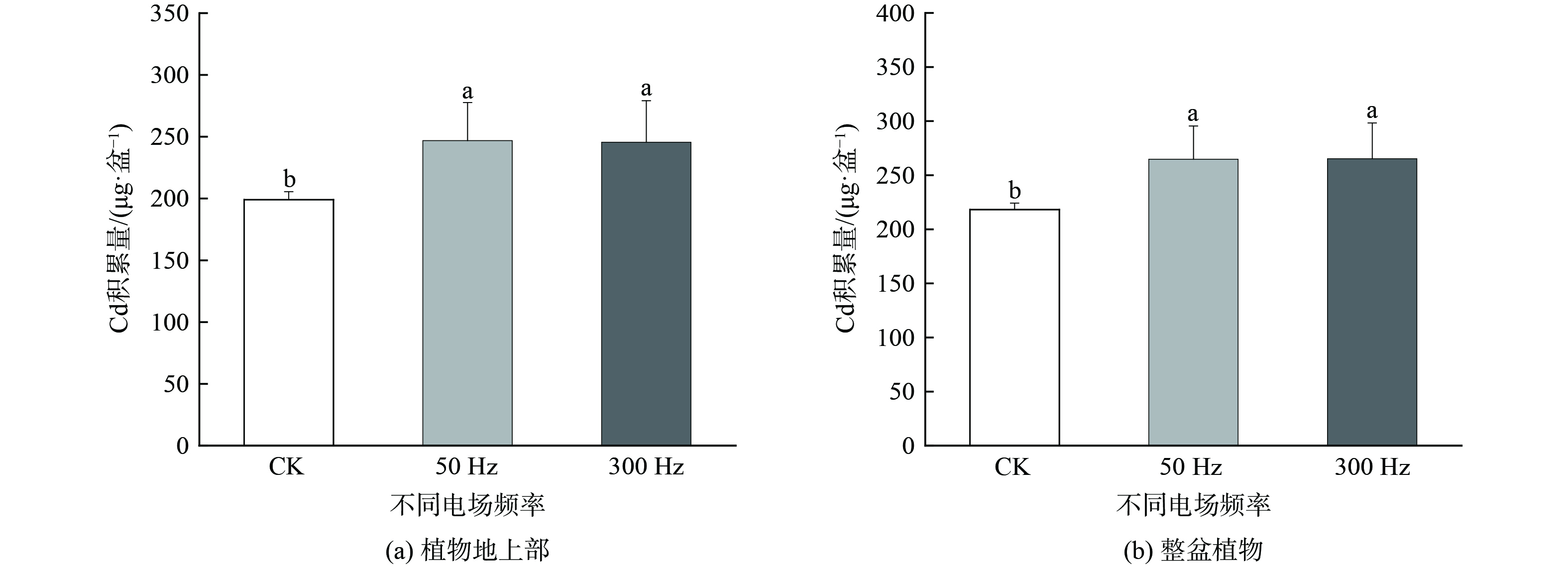-
土壤重金属污染是指人类在生产活动中将大量重金属带入土壤,严重破坏土壤生态系统的现象[1]。土壤重金属易在食用作物中富集,通过食物链在人体蓄积,严重危害人体健康[2]。在农田土壤重金属污染中,镉 (Cd) 污染是危害最严重的一种[3]。目前,土壤Cd污染修复技术主要分为物理、化学和生物修复技术。植物修复技术成本低、生态友好、易被大众接受,但其修复周期长,修复效果受植物特性如根系分布深度等的限制而存在一定局限性[4]。电动修复因其修复周期短、去除率高、能同时去除多种污染物等优点而成为一种具较好应用前景的重金属污染土壤修复技术[5]。施加直流电场时,土壤中OH−和H+分别向阴极、阳极迁移积累,造成电极处附近极化现象[6]。而交流电场不会发生土壤pH的剧烈变化,并能改善土壤均匀性[7]。将交流电场和植物修复相结合,可以通过强化植物生长、提高植物吸收重金属能力或是提高土壤中重金属的有效性来提高修复效率[8]。
已有研究表明,施加交流电场可以促进龙葵 (Solanum nigrum L) [9]、褪色柳 (Salix discolor) [10]、东南景天 (Sedum alfredii Hance) [11]、莴苣 (Lactuca sativa) [12]等植物的生长,加强Cd在植物体内的积累。除了电场类型外,电场频率也是重要的影响参数。在较短时间内,交流电场频率由50 Hz提升到400 Hz过程中,土壤重金属的浸出质量浓度有增加的趋势[13]。预试验也显示相似结果,通过土壤培养的试验方法,设置电场频率为0~400 Hz,研究电场频率对土壤Cd活性的影响,结果显示电场频率为300 Hz时,土壤有效态Cd质量分数提高最明显,为电动修复技术的优化提供了参考。HE等[14]研究发现1 Hz脉冲电场作用可以提高玉米根系生物量。此外,低频 (60 Hz) 交流电场也能促进拟南芥地上部的增长[15]。然而较高电场频率对植物生长及土壤重金属的修复作用还有待研究。
柳树以其快速生成深根系统、高生物量、高蒸腾速率和能富集重金属等优点,在重金属污染修复实践中越来越受到重视[16]。重金属Cd超积累植物东南景天生长速率较快、富集Cd能力强,是理想的植物修复材料[17],但其为浅根系植物。植物混种系统可以丰富土壤生物群落,有利于互补作物生长和改善土壤健康[18],柳树和东南景天混种能够增加植物对地面空间的利用,从而可能促进土壤修复效率的提高。先前的研究表明,交流电场促进了柳树、东南景天对土壤Cd的吸收积累[11, 19-20]。因此,本研究通过盆栽试验的方法,探讨不同的交流电场频率 (低频50 Hz,高频300 Hz) 对竹柳3号 (Salix sp.) 和东南景天混种条件的土壤理化性质、Cd有效性、植物生长和Cd吸收积累能力的影响,为土壤重金属污染治理提供新思路。
-
试验土壤:土壤采自浙江富阳某地重金属Cd污染表层0-20 cm的农田土壤,阴凉风干后过5目筛备用,试验土壤的基本理化性质见如下:pH,7.27;有机质,40.12 g·kg−1;速效钾,176.00 mg·kg−1;碱解氮,202.39 mg·kg−1;有效磷,15.25 mg·kg−1;有效态Cd,0.31 mg·kg−1;全Cd,1.68 mg·kg−1。
试验植物:将长势一致且良好的竹柳3号 (浙江绿鑫晨农开发有限公司) 剪成15 cm插条,用去离子水洗净并培育1周长根发芽以备试验;将长势一致、去顶芽、带叶片的东南景天 (浙江农林大学平山实践基地) 剪成5 cm插穗,在去离子水中洗净备用。
-
土壤盆栽试验于2022年4月进行,试验分为3个处理:对照 (CK) ,不通电;通电0.5 V·cm−1,电场频率为50 Hz (低频) ;通电0.5 V·cm−1,电场频率为300 Hz (高频) 。交流电场24 h持续开启60 d,每个处理设置3个重复,随机区组设计。每个盆栽 (直径为20 cm,高为15 cm) 装入4 kg充分混匀的试验土壤,在盆栽的直径两端放入石墨棒 (直径为1 cm,高为10 cm) ,用去离子水调节土壤含水量至土壤田间持水量的70%,每盆扦插2株竹柳,间距约为5 cm,扦插5株东南景天于周围,间距约为3 cm。扦插1周后利用变频电压器 (PA9505,东莞纳普电子科技有限公司,中国) 调节电压和频率。每天称量盆栽保持土壤水分,生长60 d后采集植物和土壤样品。图1为试验示意图。
-
土壤样品收集后在阴凉处风干,过10目和100目筛。土壤基本理化性质测定方法参照《土壤农业化学分析方法》[21]。土壤pH值采用pH计 (PB-10,赛多利斯,德国) 电位法测定 (水土比2.5∶1) ;土壤速效钾 (AK) 、碱解氮 (AN) 、有效磷 (AP) 分别采用醋酸铵浸提-火焰光度法、碱解扩散法和碳酸氢钠提取-钼锑抗比色法测定,土壤有机质质量分数 (SOM) 采用重铬酸钾外加热法。土壤有效态Cd质量分数 (ACd) 采用二乙烯三胺五乙酸-氯化钙-三乙醇胺 (DTPA-CaCl2-TEA) 浸提 (水土比2∶1) ,石墨炉原子吸收光谱仪 (AA-7000,岛津,日本) 测定。
在植物收获前 (生长60 d) 测量植物株高,并使用叶绿素仪 (SPAD-502 Plus,柯尼卡美能达,日本) 对植物成熟功能叶片 (植株从上往下数的第5片叶) 测定SPAD值。植物样品收集后用自来水、去离子水先后清洗干净,吸水纸吸收多余水分,将竹柳分为叶片、枝条、树干、根系,东南景天分为地上部和地下部,植物根系采用根扫描仪 (EPSON V700,爱普生,中国) 与Win RHIZO分析软件测定根系形态参数[22]。继续将植物各部分在烘箱中105 ℃杀青15 min后再调至70 ℃烘至恒重,测定植物干重,研磨过20目筛。硫酸-双氧水消煮植物样品,待样品消解至澄清或灰白色,定容至50 mL,石墨炉原子吸收光谱仪测定消煮液中Cd元素质量浓度[21],植物的质控样品为GBW07603 (GSV-2) 灌木树枝,回收率为93.78%。
-
不同处理的土壤基本理化性质和有效态Cd质量分数见表1。经过电场处理后,50 Hz处理的土壤pH值不变,而施加电场频率为300 Hz的处理改变了土壤pH值,与对照相比显著降低了0.13个单位。在300 Hz频率电场下土壤pH值略有降低,可能是较高的电场频率刺激了柳树根系分泌物的分泌,分泌出的H+和有机酸降低了土壤pH值[23]。土壤中AN、AP、SOM在不同处理下均无显著性差异,但300 Hz处理提高了AK。这可能是因为较高频率的电场作用调控植物和土壤微生物的代谢作用,将钾元素转化成速效钾。电动力学修复可以提高土壤有效态Cd质量分数。50 Hz处理的土壤有效态Cd质量分数高于对照10.00%,随着电场频率的提高,300 Hz处理的土壤有效态Cd质量分数显著高于对照35.00%。电场作用可以促进Cd离子从土壤颗粒中解吸出来[24],残渣态向交换态转化[10],从而提高土壤有效态Cd质量分数。电场频率的提高增加了金属离子的活性,这可能是由于300 Hz频率的交流电场电极交换频率比50 Hz频率更快,电流的快速变化可能使离子在土壤中振动频率加快并产生热量,在一定程度上可以促使金属离子的活化。
-
1) 株高和叶片SPAD值。由图2可知,不同处理下植物株高和叶片SPAD值的表现趋势一致,施加电场处理的植物株高和叶片SPAD值均增加,并且2种植物都在50 Hz电场条件下达到最大值。ELISHA等[25]研究发现,外加电场可以提高非洲龙葵 (Solanum scabrum Mill.) 叶绿素的生物合成,因为电场作用会诱导应力介质电化学质子梯度或细胞质和液泡pH等的变化,植物通过增加初级和次级代谢物生物合成 (叶绿素、类胡萝卜素) 以稳定环境的变化。叶片SPAD值表明植物叶片叶绿素的相对值,叶绿素具有捕获太阳能进行光合作用的重要作用,叶绿素值的增加可以促进树木的生长[26]。50 Hz处理相较于300 Hz处理有更好的表现,这可能是由于较高 (300 Hz) 的电场频率对植物细胞的刺激效果不及50 Hz,对植物生长的促进作用有所降低。
2) 生物量。由表2可知,施加电场可以促进植物生长,柳树生物量在50 Hz电场频率处理下效果最明显,东南景天在300 Hz电场频率处理下效果最好。中低电压电场能提高抗氧化酶活性,降低丙二醛水平,从而提高植物生物量[27]。外加电场可以刺激活细胞的电生理机能促进植物生长,提高植物生物量[28]。电场会影响植物根细胞质膜的膜电位和酶活性,增加带电离子对膜的亲和力,促进植物根系对矿物质营养吸收,从而促进植物的新陈代谢,有利于植物生长发育[29]。此外,适宜强度的电场也能调节微生物代谢和生长[30]。然而柳树生长在300 Hz交流电场时促进效果有所减弱,这可能是由于较高频率电场电解出更多的OH−,与水里氧分子催化生成超氧阴离子自由基,过量的超氧阴自由基损害脂质、核酸、蛋白质[31]。
3) 根系形态指标。表3显示,施加电场处理的柳树根系长度、根系表面积、根尖数随着电场频率的增加而提高,东南景天在50、300 Hz电场处理下根系形态指标变化不明显,在300 Hz电场处理时东南景天的根系长度、根尖数分别高于对照1.39%、6.90%。旺盛的根系可能通过增加水分和必需矿物质的吸收速率来促进植物的生长[32]。电刺激下可以直接影响植物根系的生长。此前有研究表明,外加电场显著增加了禾本科的根直径、根长,在根表面覆盖了大量的根毛,促进养分的吸收[33]。本研究结果也显示,电场频率处理均提高了柳树根系形态的指标,从而有利于促进地上部生长。
-
1) 植物Cd质量分数。由表4可知,施加电场会影响植物各部位对土壤Cd的吸收,50 Hz处理柳树叶片、枝条、树干和根系Cd质量分数较对照分别降低22.16%、29.82% (P<0.05)、1.49%、15.91% (P<0.05),300 Hz处理柳树叶片、枝条、树干和根系Cd质量分数较对照分别降低11.38%、17.55% (P<0.05)、1.68%、18.58% (P<0.05)。在电场作用下东南景天地上部吸收Cd能力随着电场频率的增加而显著提升,50、300 Hz处理东南景天地上部Cd质量分数较对照分别增加43.37%、55.18% (P<0.05) 。相反,东南景天地下部Cd质量分数在50 Hz电场下受到明显的抑制,较对照显著降低31.81%。交流电场的应用使柳树植物各部位Cd质量分数下降,这可能因为电场作用刺激柳树根系分泌有机酸,在根系和细胞壁对Cd的滞留作用下,限制了柳树对Cd的吸收和Cd向地上部的运输[34]。电场作用提高了东南景天地上部的Cd质量分数,这是因为电场可以驱动可溶性重金属到达植物根部,同时也增强了金属从根部向地上部分的转运[35]。交流电场通过以下方式提高植物吸收重金属的能力:电场作用下的电渗透可以引起金属离子的剧烈运动,促使更多的金属离子和络合物向植物根部移动[36];间歇性的电脉冲使植物膜细胞超极化和去极化,激活了离子通道[37];适当的电场可以改善土壤的结构、渗透性、氧化还原电位和微生物菌群,提高植物修复效率[38]。
2) 植物Cd积累量。表5和图3中植物Cd积累量显示,在本研究土壤环境下,2种植物对电场频率的响应不同。50 Hz电场可以显著促进柳树的Cd积累,在300 Hz电场条件下,柳树Cd积累量有所增加但不显著。电场作用提高了东南景天的Cd积累量,300 Hz比50 Hz处理更能促进东南景天的Cd积累量的增加。50、300 Hz处理植物地上部Cd总积累量和植物总Cd积累量大致相当,均显著高于CK处理。50 Hz电场处理植物地上部Cd总积累和总Cd积累量分别显著高于对照24.04%、23.38%,300 Hz电场处理植物地上部Cd总积累和总Cd积累量分别高于显著对照21.24%、21.56%。试验结果表明,柳树Cd主要积累在植物的地上部分,并且Cd积累量主要归功于柳树生物量的增加。对柳树而言,交流电场 (50 Hz) 处理下柳树地上部Cd积累量显著高于不加电场处理。但随着电场频率的增加,柳树地上部分Cd积累量增加减弱,说明300 Hz频率会抑制柳树的地上部分Cd积累。对东南景天来讲,地上部Cd积累量的增加主要是吸收Cd能力的提高。交流电场可促进东南景天生长和重金属的吸收积累[39],在50、300 Hz交流电场条件下,东南景天地上部吸收能力Cd和积累量显著提升,并且较高频率 (300 Hz) 的电场的提升效果更佳,同时,东南景天地下部吸收Cd能力和Cd积累量在50 Hz频率呈下降趋势,而在300 Hz交流电场处理下有所回升,这都说明300 Hz频率可以在一定程度上加速Cd吸收和积累。
-
由上述试验结果得出,该模式下植物地上部Cd积累量约为7.80 mg·m−2,即可从土壤中带走的重金属Cd的量。若农田土壤Cd质量分数以0.60 mg·kg−1计,有效耕作层以20 cm计算,那么农田表层 (0~20 cm) 所含的重金属Cd约为144 mg·m−2。因此,当本装置应用在实际农田中,植物种植一茬可以带走污染土壤5.42%的Cd。若农田得到良好的田间管理,每年种植3茬,连续3 a后可使得土壤恢复到安全利用水平。
本试验使用的变频电压器市售价人民币1 800元,设备运行时只消耗电能,耗电量0.04 kWh,电费成本极低。若将该装置应用于农田土壤修复中,变频电压器、石墨棒、导线及能耗的花费约255 000元·hm−2。变频电压器的使用寿命为8 a,且石墨棒的损耗很小。因此,本装置可运行多年。变频电压器的单价相对较高,但随着技术的发展,变频电压器的价格会逐渐下降,因此未来成本可能会进一步降低。从安全性来说,通电时的电流值极小,并且随着频率的增加,人体触电的危险程度会下降。交流电场可以影响土壤中的微生物和离子的活动,从而影响土壤环境,良好的土壤环境促进植物的生长和修复能力[40]。结合本研究结果,电场频率促进柳树和东南景天地上部分吸收和积累Cd,缩短了植物修复时间,降低治理成本,从而在一些需要快速修复的场景中有广泛的应用前景,但仍要在实践中进一步探索和应用。
-
1) 在柳树-东南景天混栽的模式下,交流电场可以增加土壤有效态Cd的质量分数,50、300 Hz处理的土壤有效态Cd质量分数分别是对照的1.10倍和1.35倍。
2) 适宜的交流电场 (50、300 Hz) 有助于提高柳树和东南景天的生物量生长。随着电场频率的增加,柳树的生物量呈现先增加后降低的趋势,而东南景天的生物量则随电场频率的增加而增加。
3) 交流电场 (50、300 Hz) 可以促进柳树和东南景天地上部分吸收积累Cd,低频 (50 Hz) 更有利于柳树对土壤Cd的吸收积累,较高频率 (300 Hz) 则更有利于东南景天对土壤Cd的吸收积累。
4) 电场联合植物修复装置需要一定的初期成本投入,但运维成本极低,对人体较为安全,修复效率较高,治理效果较好,具有较好的应用前景。
交流电场频率对柳树-东南景天混栽修复镉污染土壤的影响
Effect of AC electric field frequency on remediation of cadmium contaminated soil by willow- Sedum alfredii Hance mixed planting
-
摘要: 单一植物吸收的方法修复镉 (Cd) 污染土壤效果欠佳,交流电场联合植物可以更好地提高土壤Cd污染的治理效率。通过优化电场频率等参数可以提高土壤Cd的移动性,促进植物吸收土壤Cd。采用土壤盆栽试验的方法,研究交流电场频率 (50、300 Hz) 对竹柳3号和东南景天混种条件下土壤理化性质、Cd有效性、植物生长和Cd吸收积累能力的影响。与对照 (没有施加电场) 相比,300 Hz电场处理的土壤pH值显著降低了0.13。电场频率的提高显著提升了土壤Cd的有效性,300 Hz频率电场处理的土壤有效态Cd质量分数显著高于对照35.00%。交流电场促进了植物生长,柳树和东南景天的株高、生物量、叶片SPAD值及根系形态指标在外加50、300 Hz交流电场时均得到提高。交流电场降低了柳树各部分和东南景天地下部Cd质量分数,其中50 Hz处理柳树叶片、枝条、树干、根系和东南景天地下部Cd质量分数较对照分别降低22.16%、29.82% (P<0.05) 、1.49%、15.91% (P<0.05) 、31.81% (P<0.05) 。相反,电场频率的提高有利于东南景天地上部Cd质量分数增加,50、300 Hz处理东南景天地上部Cd质量分数较对照分别增加43.37%、55.18% (P<0.05) 。交流电场提高了植物对土壤Cd吸收积累,但不同的电场频率对植物Cd修复效率影响不同,50、300 Hz交流电场下植物地上部分总Cd积累量较对照分别显著增加24.04%、21.24%。从这2种植物上看,50 Hz交流电场更能提高柳树Cd修复效率,300 Hz交流电场更提高能东南景天Cd修复效率。本试验装置成本较低,修复效果较好,对于电场频率增强植物修复Cd效率具有很大参考价值,有较好的应用前景。Abstract: The single plant uptake method for remediation of cadmium (Cd) contaminated soil is often low efficient, while alternating current (AC) electric field combined with plants can be better for soil Cd contamination. By optimizing parameters such as electric field frequency can improve the mobility of soil Cd, promote plant uptake of soil Cd. A soil pot experiment was conducted to study the effects of (AC) electric field frequency (50 and 300 Hz) on soil physical and chemical properties, Cd availability, plant growth and Cd absorption and accumulation under the mixed planting conditions of willow (Salix sp.) and Sedum alfredii Hance. Compared to the control treatment (without application of AC electric field), the 300 Hz frequency electric field treatment significantly reduced the soil pH value by 0.13 unit. The increase of electric field frequency significantly improved the availability of Cd in soil, and the soil available Cd concentrations of 300 Hz frequency electric field treatment was significantly higher than that of the control by 35.00%. The plant height, biomass, leaf SPAD value and root morphology parameters of willow and Sedum alfredii Hance were all improved when 50 Hz or 300 Hz AC electric field was applied. The AC fields reduced Cd concentrations in all parts of willow and in the underground part of Sedum alfredii Hance. The Cd concentrations in the willow leaves, branches, trunks, roots and underground parts of Sedum alfredii Hance treated with 50 Hz decreased by 22.16%, 29.82% (P<0.05), 1.49%, 15.91% (P<0.05) and 31.81% (P<0.05), respectively, compared with the control. The Cd concentrations in the aboveground part of Sedum alfredii Hance increased by 43.37% and 55.18% (P<0.05) in the 50 Hz and 300 Hz treatments, respectively, compared with the control. The increase of electric field frequency improved plant uptake of soil Cd and the efficiency of soil Cd phytoremediation changed with the applied electric field frequency. The total Cd accumulation in the aboveground parts of plants under 50 Hz and 300 Hz AC fields increased significantly by 24.04% and 21.24%, respectively, compared to the control. In terms of the tested two plants, the 50 Hz AC field improved the Cd remediation efficiency of willow more than that of the 300 Hz, and the 300 Hz AC field improved the Cd remediation efficiency of Sedum alfredii Hance more more than that of the 50 Hz. The experimental setup had a low cost and high restoration efficiency, providing valuable reference for using electric field frequency to enhance phytoremediation efficiency for Cd, with promising application prospects.
-
Key words:
- AC electric field /
- electric field frequency /
- phytoremediation /
- cadmium /
- soil
-
我国是印染大国,纺织印染行业是我国的支柱产业之一。2016年,我国规模以上印染企业印染布产量9.7×1010 m[1],在环保压力提升的背景下,中小企业因环保压力被动停产或寻求兼并,印染行业的区域集中度逐渐提高。我国印染行业主要集中在东部沿海地区,截至2015年,浙江地区已经汇集了全国接近63%的印染行业产能[2]。印染行业在带来巨大经济利益的同时,也带来了非常严重的环境污染问题[3],尤其是VOCs的污染问题。印染行业作为纺织行业的关键行业,生产过程中需要使用大量挥发性助剂,目前我国印染助剂年使用量为1.2×105 t[4],助剂的大量使用导致了严重的VOCs污染,2012年,长江三角洲区域纺织印染行业VOCs总排放量达到7.5×104 t[5]。VOCs与PM2.5的形成有密切关系,也是光化学烟雾的源头,如果未经治理的印染废气大量排放,会直接影响大气环境,部分有毒VOCs长期累积排放会直接影响企业职工的身体健康,容易造成职工的呼吸道疾病,甚至发生癌变,还会影响周边居民的生活质量[6],印染行业的VOCs排放问题也因此获得重点关注。我国于2015年推出了《纺织染整工业大气污染物排放标准》[7],其中关于VOCs的各项标准相比于之前沿用的《大气污染物综合排放标准》[8]和《恶臭污染物排放标准》[9]更加严格。目前,我国缺乏印染废气尤其是VOCs的产生特征及去除特性研究,这增加了印染废气的处理难度,因此,研究印染行业VOCs产生特征是十分必要的。本研究以浙江省内一家典型的印染企业为研究对象,着重对该企业内3个分厂进行废气监测,以了解其VOCs的产生特征,为进一步了解印染VOCs产生特征以及提高印染废气治理效果提供参考,为解决印染VOCs污染提供技术支持。
1. 采样与分析方法
1.1 调研企业概况
本研究选取了浙江省印染企业高度集聚区的一家典型印染企业。该企业每年印染布产量达7.8×107 m,每年印染布产量为2.5×104 t。本研究对该企业3个印染分厂(产品分别为针织布、梭织布以及化纤涤纶布,编号为A分厂、B分厂、C分厂)及印染污水站进行VOCs产生特征的探究。有组织废气源主要包括定型机、配料间及污水站。该企业对A分厂和B分厂定型机废气采用“间接冷却+静电除尘”装置进行治理,对C分厂定型机废气采用“水喷淋+静电除尘”装置进行废气治理,对各分厂配料间废气及污水站废气采用“次氯酸钠洗涤+碱洗”二级喷淋装置进行治理。
1.2 采样及测定点位
印染行业的工艺流程主要包括胚布准备、前处理、后整理和成品4个阶段,各个印染企业使用的工序及原料会有所不同,但是整体工艺流程[10]相似。
该企业各废气源如图1所示。该企业共有45台定型机,定型机废气主要来自胚布表面溶剂的受热挥发[11];配料间包括配料车间和染料仓库,配料间产生的废气主要是来自于配料过程中助剂染料的挥发,也包括染料仓库中存放的助剂及染料的自然挥发;该企业污水站恶臭气体的主要产生单元包括调节池、水解酸化池及污泥浓缩池,所产生的废气经负压管道收集后经过处理直接排放。故选择以上3个有组织废气源作为废气监测点。经过现场调研了解到,印染企业中无组织废气主要来自设备运行以及配料间的配料过程,所以选取染色定型车间以及定型车间进行无组织废气特征测定。同时,污水站内未封闭的处理单元也会产生一定的无组织废气,故污水站无组织废气测定点选择好氧池、厌氧池、初沉池。在无组织废气测定过程中,车间内依据印染设备不同距离各取3个点位进行测定,对污水站各处理单元附近上下风向各取3个点位进行测定。针对该企业各分厂的废气处理装置,测定点位选取在各废气装置的进出气口,监测指标为VOCs浓度及H2S浓度。
1.3 分析方法
废气测定指标包括温度、湿度、流量、VOCs浓度、VOCs组分。其中温度采用Testo 905-T1-温度计测量。湿度采用Testo 605-H1-温湿度仪测量。废气流量通过废气气速与废气排风管横截面积计算,流速使用Testo 416 -精密型叶轮风速仪进行测量。VOCs浓度采用PhoCheck Tiger VOC检测仪进行现场测定。VOCs采样方法采用固相微萃取采样(SPME),采样点设在各测定点尾气收集管道内,将SPME萃取头伸入废气管道内部,吸附采样时间为10 min。VOCs组分测定采用国家标准方法(HJ 73-4-2014),即“SPME+气相色谱质谱联用仪(GC-MS)”检测方法[12]。采用安捷伦气相色谱/质谱联用仪,将SPME萃取头插入进样口,吸附在萃取头上的VOCs物质随着高纯氦气(纯度99.999%)进入HP-5ms色谱柱(30 m×0.25 mm×1 μm,Agilent Technologies,美国)中进行分离。气体经分离后进入ECD检测器、FID检测器、质谱监测仪,依据各物质停留时间以及峰面积,对VOCs组分进行定性半定量分析。针对废气处理装置增加了进出气H2S浓度指标的测定,采用HND88式便携式H2S检测仪进行检测分析。
2. 结果与讨论
2.1 废气温度、湿度、产生量及VOCs浓度
由于染色和漂洗过的纺织品需要在定型机内进行烘干拉幅和热处理[13],同时纺织品上携带的水分受热大量蒸发,所以定型机所产生的废气平均温度和湿度较高,平均温度为135 ℃,相对湿度已饱和;配料间内无加热装置,产生废气的温度为24 ℃,与室温相近,废气湿度随配料间配料时间的改变而变化;污水站废气温度约为26 ℃,湿度为60%~70%。
该企业各有组织废气的废气特征如表1所示,定型机、配料间及污水站产生的有组织废气流量分别为8.6×105、7.4×104、2.8×104 m3·h−1,产生的VOCs平均浓度分别为14.7、9.0和14.9 mg·m−3。《纺织染整工业大气污染物排放标准》对VOCs限值为40 mg·m−3,《大气污染物综合排放标准》对非甲烷总烃的限值为120 mg·m−3,排放速率限值为15 kg·h−1,各废气源的VOCs浓度均满足排放标准的要求。
表 1 各有组织废气源废气特征Table 1. Characteristics of organized exhaust gas from different sources废气源 分厂 废气产生量/(104 m3·h−1) VOCs浓度/(mg·m−3) 总气源数量/个 总废气产生量/(×104 m3·h−1) 总VOCs产生速率/(kg·h−1) 定型机 A 1.9±0.3 14.5±0.6 45 86.9±9.9 12.8±1.6 定型机 B 1.7±0.2 15.7±0.5 定型机 C 2.0±0.2 14.1±0.9 配料间 B 1.8±0.4 8.8±0.1 5 7.4±2.9 6.57±0.31 配料间 C 1.3±0.4 9±0.2 污水站 — 2.8±0.2 14.9±0.7 1 2.8±1.5 4.13±0.6 由于该印染企业配料间及污水站废气产生量较低,且配料间为非连续运行模式,每天工作时间不定,平均为3 h,所以印染企业生产过程中,定型机是最大的VOCs产生源。通过调研了解到,企业每年运行约300 d,定型机和污水站每天运行约20 h,配料间每天工作约3 h,由此计算得该企业每年定型机总VOCs产生量约为76.8 t,配料间VOCs年产生量约为0.6 t,污水站VOCs年产生量为2.5 t,企业每年VOCs产生总量约为79.9 t,印染过程中VOCs产生量约为31.9 kg·t−1 (产品)。
各无组织废气源的VOCs浓度如图2所示。染色车间VOCs平均浓度在0.16 mg·m−3左右。相比染色车间,定型车间内的VOCs浓度要高得多,浓度为0.1~1.9 mg·m−3,平均浓度约为0.66 mg·m−3,污水站的VOCs浓度为0.1~1.1 mg·m−3,平均浓度约为0.59 mg·m−3。定型车间和污水站产生无组织VOCs浓度具有区域性,不同测定点VOCs浓度差异较大。
2.2 各有组织废气源的VOCs组分特征
2.2.1 定型机产生的VOCs组分特征
在热定型过程中,纤维布料上残留的有机物受热挥发,产生大量VOCs气体,VOCs气体组分易受到定型过程中助剂成分的影响。各分厂定型机VOCs组分如图3所示。A分厂定型机所产生的VOCs中氟代烃为主要物质,包括占比为22.7%的五氟丙酸三十八烷酯以及占比为23.3%的五氟丙酸三十烷酯。这是由于印染行业中经常会使用含氟的有机润滑剂(如氯化三氟乙烯、氟硅类、二酯、矿物油等物质),染色过程也会使用含氟的活性染料[14],其他VOCs还包括烷烃、异喹啉等。B分厂定型机的VOCs与A分厂定型机VOCs组分类似,同样是以卤代有机物为主,卤代有机物中的卤素为氯与氟,典型组分包括占比为12.2%的五氟丙酸三十八烷酯,以及占比为3.7%的三氯甲烷,其他VOCs组分包括乙二醇丁醚、二十一烷等物质,乙二醇醚类是印染过程常用的有机溶剂[15]。相关毒理学研究[16]表明,乙二醇醚类对人具有血液毒性、肝肾毒性等的不良影响。C分厂定型机废气VOCs检测出的成分以苯系物为主,VOCs中典型污染物为苯甲酸苄酯,约占为72%,苯甲酸苄酯主要用作乙酸纤维和硝酸纤维的溶剂,塑料增塑剂[17]。C分厂定型机VOCs的成分与A、B分厂有很大差异,主要原因为C分厂的加工产品为化纤布,在化纤布印染过程中会大量使用苯类助剂[18]。
2.2.2 配料间产生VOCs的组分特征
配料间所挥发出的VOCs组分取决于使用助剂的成分及挥发性,配料间非连续的工作时间及不同的配料方式也易对VOCs的组分产生影响,所以B分厂及C分厂的VOCs组分测定目的仅为确定印染配料间的典型VOCs组分,各分厂配料间组分如图4所示。B分厂配料间检测出的VOCs组分主要包括苯系物、卤代烃,VOCs组分与B分厂定型机测出的组分十分类似,如图4所示,VOCs主要包括含氟有机物、苯甲酸苄酯等物质。C分厂配料间所产生VOCs的组分十分复杂,VOCs主要为苯系物,主要成分包括蒽、甲基萘、甲基菲、甲基芴等。
印染企业配料间VOCs与定型机所产生VOCs组分类似,表明定型机所挥发出的VOCs组分受使用助剂种类影响较大,所以降低定型机产生的VOCs应该重点关注印染配料所使用的原料助剂的种类。
2.2.3 污水站产生VOCs的组分特征
印染企业耗水量大,且其中含有高浓度的染料、印染助剂等有机物,污水处理过程中挥发出的VOCs组分也因为污水中的多种溶剂变得十分复杂[19],VOCs的成分特征如图5所示。印染污水处理过程所产生的VOCs包括蒽、乙醛、甲基辛基醚、十八腈等物质,甲基辛基醚占总VOCs比例为12%;其余VOCs包括1-醋酸-8-甲基-9-十四烯酯,占比为33.50%,蒽占比为16.30%。蒽类芳香族有机化合物同样也是印染污水中的主要污染物[20],十八腈常用作印染布料的表面活性剂[21]。
2.3 印染VOCs去除特性及处理技术分析
2.3.1 印染VOCs去除特性
该企业针对印染废气安装了“间接冷却+静电除尘”、“喷淋+静电除尘”和“次氯酸钠洗涤+碱洗”3类处理系统。根据卢滨等[22]对杭州市工业源VOCs治理设施的调研结果,在杭州市的纺织印染企业的废气治理设施中,“静电除尘”和“水/酸/碱吸收”占比分别为46.47%和20%。说明静电除尘及“水/酸/碱吸收”是印染企业常用的废气治理设施,对该企业各废气处理装置的测定结果具有一定的代表意义。各处理装置对VOCs的处理效果如图6所示。“间接冷却+静电除尘”装置对定型机的VOCs去除率仅为2%~6%,“水喷淋+静电除尘”装置对VOCs去除率为15%~40%,其中“水喷淋”阶段对VOCs去除率较高,去除率为13%~32%,水喷淋之后的静电除尘装置对VOCs去除率依然很低,表明印染企业增设的静电除尘装置对VOCs几乎没有去除能力。“次氯酸钠洗涤+碱洗二级喷淋”装置对VOCs具有一定的去除效果,但是各分厂配料间所挥发出的VOCs组分不同,喷淋装置对VOCs处理率差异较大,去除率为8%~58%。二级喷淋装置对污水站的H2S仅有57%的去除率。
2.3.2 印染废气治理技术分析
定型机产生废气气量较大,不仅含有油滴等颗粒物,也含有浓度较低的VOCs污染物,虽然静电除尘装置对定型废气中颗粒物的去除具有一定效果,但是该技术对VOCs去除效果较差。企业单台静电除尘装置投资费用为250万元,企业总静电除尘装置每日所耗电费约为1.5万元,且每套装置每天需停止运行0.5 h进行人工清洁,存在着能耗较大,维护成本较高等问题,定型机废气处理技术的提升方向应该重点关注这几方面的问题。
配料间为非连续废气源,废气产生量较小,VOCs浓度较低,“次氯酸钠+碱洗”二级喷淋塔投资较低,配料间所配置的喷淋塔投资为20万元,且二级喷淋塔运行灵活,适合配料间的废气治理。
污水站所产生的废气量较大,目前使用的二级喷淋塔对于大风量的废气处理,存在药剂量消耗大、产生大量废液的问题,该企业污水站的二级喷淋装置每天需要消耗20 kg次氯酸钠溶液,10 kg碱液。生物法已经在各行业污水厂废气治理领域得到广泛应用,对于印染企业污水站所产生的大风量、低浓度VOCs的废气,可以选择生物法作为印染污水厂的废气治理技术,生物法对印染污水站所产生的苯系物、酯、醚、H2S等物质去除效果较好[23],污水站的VOCs的产生特征符合生物法的应用条件。
3. 结论
1)定型机废气具有高温、高湿的物理特征,且定型机废气是印染废气的主要来源,该企业各废气定型机、配料间及污水站产生的有组织废气流量分别为8.6×105、7.4×104、2.8×104 m3·h−1,产生的VOCs平均浓度分别为14.7、9.0和14.9 mg·m−3。该企业每年总VOCs产生量可达79.8 t,经估算得,印染过程中VOCs产生量约为31.9 kg·t−1 (产品)。印染企业各车间无组织VOCs平均浓度较低,但是VOCs浓度分布具有区域性,需要对定型车间中VOCs浓度较高的区域增加相应的处理措施。因此,建议增大通风量,或者完善定型机废气收集系统。
2)印染行业VOCs成分复杂,且多为大分子物质,虽然不同分厂VOCs组分相差较大,但是各有组织废气源VOCs组分种类类似,VOCs中的苯系物主要包括苯甲酸苄酯、蒽类、喹啉类等,氟代有机物包括五氟丙酸酯及氯代有机物,印染VOCs主要来源于印染助剂的挥发。
3)印染企业各类废气处理装置对印染VOCs的去除效果差异较大,对于VOCs产生量最大的定型机,所采用的废气治理技术主体为静电除尘装置,静电除尘对印染VOCs去除率仅为2%~6%,说明印染企业针对定型机VOCs并未采取有效的控制措施,同时静电除尘装置存在着能耗大、维护成本高等问题。二级喷淋对配料间及污水站的VOCs去除率为8%~58%,对于印染污水站的VOCs治理,生物法是应用前景较好的技术。
-
表 1 不同处理对土壤基本理化性质和有效态Cd的影响
Table 1. Effects of different treatments on basic physical and chemical properties and available Cd of soil
处理组 pH AK/ (mg·kg−1) AN/ (mg·kg−1) AP/ (mg·kg−1) SOM/ (g·kg−1) ACd/ (mg·kg−1) CK 7.40±0.01a 48.00±3.61b 170.98±4.36a 20.80±6.41a 48.20±2.48a 0.20±0.01b 50Hz 7.40±0.03a 47.00±5.00b 167.03±4.40a 25.92±5.55a 45.31±2.31a 0.22±0.01b 300Hz 7.27±0.04b 59.00±1.00a 166.24±5.48a 17.38±1.28a 44.85±1.34a 0.27±0.03a 注:同列数据后不同小写字母代表不同处理间达到显著水平 (P<0.05) 。 表 2 不同处理对植物生物量的影响
Table 2. Effects of different treatments on plant biomass
g·株−1 处理组 柳树干重 东南景天干重 叶片 枝条 树干 根系 整株 地上部 地下部 整株 CK 2.47±0.08b 1.30±0.03b 5.10±0.04b 0.72±0.04b 9.58±0.16b 0.38±0.01b 0.06±0.01b 0.44±0.01b 50Hz 3.83±0.94a 2.04±0.38a 6.04±0.40a 0.82±0.02a 12.74±1.56a 0.41±0.01ab 0.07±0.00a 0.48±0.01a 300Hz 3.15±0.27ab 1.65±0.15ab 5.80±0.22a 0.80±0.03a 11.40±0.61ab 0.43±0.03a 0.08±0.01a 0.51±0.03a 表 3 不同处理对植物根系形态的影响
Table 3. Effects of different treatments on plant root morphology
植物类型 处理组 根系长度/cm 根系表面积/cm2 根系直径/mm 根系体积/cm3 根尖数 柳树 CK 1363.43±154.86b 453.72±69.32b 1.15±0.13a 13.06±2.74a 6193.00±1136.34b 50 Hz 1853.87±262.70a 482.89±82.76ab 1.02±0.13a 11.50±2.32a 7299.00±1151.26ab 300 Hz 1881.06±54.72a 633.98±142.02a 1.08±0.25a 14.27±6.70a 8183.67±1179.85a 东南景天 CK 291.08±37.13a 36.16±6.10a 0.39±0.03a 0.36±0.08a 3787.50±535.05a 50 Hz 307.34±57.43a 36.76±4.62a 0.39±0.06a 0.36±0.09a 3724.40±574.26a 300 Hz 295.13±28.80a 33.97±4.86a 0.38±0.06a 0.33±0.06a 4049.00±570.39a 表 4 不同处理对植物各部位Cd质量分数的影响
Table 4. Effects of different treatments on Cd concentrations in different parts of plants
mg·kg−1 处理组 柳树 东南景天 叶片 枝条 树干 根系 地上部 地下部 CK 11.95±0.81a 16.87±1.08a 5.36±1.30a 8.61±0.15a 21.93±2.40b 24.02±1.40a 50 Hz 9.30±1.29a 11.84±0.61b 5.28±0.38a 7.24±0.13b 31.44±6.43ab 16.38±1.85b 300 Hz 10.59±2.71a 13.91±1.41b 5.27±0.73a 7.01±0.32b 34.03±6.19a 21.17±1.29a 表 5 不同处理对植物Cd积累量的影响
Table 5. Effects of different treatments on Cd accumulation in plants
μg·株−1 处理组 柳树Cd积累量 东南景天Cd积累量 叶片 枝条 树干 地上部 根系 地上部 地下部 CK 29.51±2.89a 21.87±1.82a 27.28±6.44a 78.65±3.88b 6.20±0.31a 8.34±0.80b 1.36±0.08b 50 Hz 35.55±10.37a 23.96±3.28a 31.95±3.52a 91.46±16.04a 5.96±0.09a 12.79±2.26ab 1.20±0.12b 300 Hz 32.98±6.39a 22.85±2.19a 30.46±3.28a 86.29±8.28ab 5.58±0.07b 14.60±3.51a 1.70±0.09a -
[1] 刘志坚, 董元华, 张琇, 等. 卫宁平原农用地土壤重金属污染特征与生态风险研究[J]. 生态环境学报, 2022, 31(11): 2216-2224. [2] RAI P K, LEE S S, ZHANG M, et al. Heavy metals in food crops: Health risks, fate, mechanisms, and management[J]. Environment International, 2019, 125: 365-385. doi: 10.1016/j.envint.2019.01.067 [3] 黄卫, 庄荣浩, 刘辉, 等. 农田土壤镉污染现状与治理方法研究进展[J]. 湖南师范大学自然科学学报, 2022, 45(1): 49-56. doi: 10.7612/j.issn.1000-2537.2022.1.hnsfdx-zr202201006 [4] 杨滨娟, 黄国勤. 植物种植修复土壤重金属污染的模式、技术与效果综述[J]. 生态科学, 2022, 41(4): 251-256. [5] 李亚林, 刘蕾, 段万超, 等. 电动修复技术对土壤中镉迁移的影响[J]. 环境工程学报, 2016, 10(10): 6021-6027. doi: 10.12030/j.cjee.201603113 [6] CHIRAKKARA R A, REDDY K R, CAMESELLE C. Electrokinetic amendment in phytoremediation of mixed contaminated soil[J]. Electrochimica Acta, 2015, 181: 179-191. doi: 10.1016/j.electacta.2015.01.025 [7] 刘玥, 牛婷雨, 李天国, 等. 电动力学辅助植物修复重金属污染土壤的特征机制与机遇[J]. 化工进展, 2020, 39(12): 5252-5265. [8] 魏树和, 徐雷, 韩冉, 等. 重金属污染土壤的电动-植物联合修复技术研究进展[J]. 南京林业大学学报(自然科学版), 2019, 43(1): 154-160. [9] XU L, DAI H, SKUZA L, et al. The effects of different electric fields and electrodes on Solanum nigrum L. Cd hyperaccumulation in soil[J]. Chemosphere, 2020, 246: 125666. doi: 10.1016/j.chemosphere.2019.125666 [10] 刘波, 陈绩, 马嘉伟, 等. 交流电场和水分对褪色柳-东南景天混栽修复镉污染土壤的影响[J]. 浙江农林大学学报, 2021, 38(6): 1238-1244. [11] 陈绩. 养分措施管理对交流电场下东南景天修复重金属污染土壤效率的影响[D]. 杭州: 浙江农林大学, 2019. [12] BI R, SCHLAAK M, SIEFERT E, et al. Alternating current electrical field effects on lettuce (Lactuca sativa) growing in hydroponic culture with and without cadmium contamination[J]. Journal of Applied Electrochemistry, 2010, 40: 1217-1223. doi: 10.1007/s10800-010-0094-x [13] 杨光. 外加电场促进土壤重金属化学钝化研究[D]. 重庆: 重庆大学, 2019. [14] HE R R, XI G, LIU K. Alleviating effect of extremely low frequency pulsed electric field on drought damage of maize seedling roots[J]. Journal of Luminescence, 2017, 188: 441-447. doi: 10.1016/j.jlumin.2017.04.042 [15] IWATA S, OKUMURA T, MURAMOTO Y, et al. Influence of AC electric field on plant growth[C]//2011 Annual Report Conference on Electrical Insulation and Dielectric Phenomena. Cancun, Mexico: IEEE, 2011: 179-182. [16] 谢探春, 王国兵, 尹颖, 等. 柳树对镉-芘复合污染土壤的修复潜力与耐受性研究[J]. 南京大学学报(自然科学), 2019, 55(2): 282-290. [17] 肖文丹, 叶雪珠, 徐海舟, 等. 直流电场与添加剂强化东南景天修复镉污染土壤[J]. 土壤学报, 2017, 54(4): 927-937. [18] EHRMANN J, RITZ K. Plant: soil interactions in temperate multi-cropping production systems[J]. Plant and Soil, 2014, 376(1-2): 1-29. doi: 10.1007/s11104-013-1921-8 [19] 倪幸, 李雅倩, 王胜男, 等. 交流电场促进柳树修复镉污染土壤[J]. 环境化学, 2019, 38(10): 2376-2385. doi: 10.7524/j.issn.0254-6108.2018112203 [20] MAO Z S, LIU B, FANG X Z, et al. Effects of different fertilizer treatments on AC electric field–assisted phytoremediation efficiency of Cd-contaminated soil by willow and Sedum[J]. Journal of Soils and Sediments, 2022, 22: 1460-1468. doi: 10.1007/s11368-022-03148-5 [21] 鲁如坤. 土壤农业化学分析方法[M]. 北京: 中国农业科技出版社, 2000. [22] 潘雄波, 向丽霞, 胡晓辉, 等. 外源亚精胺对盐碱胁迫下番茄幼苗根系线粒体功能的影响[J]. 应用生态学报, 2016, 27(2): 491-498. doi: 10.13287/j.1001-9332.201602.009 [23] 李欣雨, 刘函亦, 薛少琪, 等. 几种绿肥的根系分泌物对土壤锌的活化效应[J]. 中国土壤与肥料, 2022(1): 81-89. doi: 10.11838/sfsc.1673-6257.20512 [24] CAMESELLE C, CHIRAKKARA R A, REDDY R K. Electrokinetic-enhanced phytoremediation of soils: Status and opportunities[J]. Chemosphere, 2013, 93(4): 626-636. doi: 10.1016/j.chemosphere.2013.06.029 [25] ELISHA O G, SUSANNE H K, ANJA K, et al. Impact of direct-electric-current on growth and bioactive compounds of African nightshade (Solanum scabrum Mill. ) plants[J]. Journal of Applied Botany and Food Quality, 2016, 89: 60-67. [26] 曹福亮, 吴家胜, 张往祥. 氮磷钾对银杏苗生长和生理特性的影响[J]. 南京林业大学学报(自然科学版), 2003(1): 63-66. [27] XU L, DAI H, SKUZA L, et al. Optimal voltage and treatment time of electric field with assistant Solanum nigrum L. cadmium hyperaccumulation in soil[J]. Chemosphere, 2020, 253: 126575. doi: 10.1016/j.chemosphere.2020.126575 [28] BI R, SCHLAAK M, SIEFERT E, et al. Influence of electrical fields (AC and DC) on phytoremediation of metal polluted soils with rapeseed (Brassica napus) and tobacco (Nicotiana tabacum)[J]. Chemosphere, 2010, 83(3): 318-326. [29] 聂斌. 外加直流电场对植物吸收镉的影响研究[D]. 重庆: 重庆大学, 2015. [30] 那日, 冯璐. 我国静电生物学效应机理研究新进展[J]. 物理, 2003(2): 87-93. [31] 卢守波. 微电场—人工湿地耦合系统处理重金属废水初探[D]. 上海: 东华大学, 2011. [32] LEE S, OH M M. Electric Stimulation Promotes Growth, Mineral Uptake, and Antioxidant Accumulation in Kale (Brassica oleracea var. acephala)[J]. Bioelectrochemistry, 2020, 138: 107727. [33] SCOPA A, COLACINO C, BARONE LUMAGA M R, et al. Effects of a weak DC electric field on root growth in Arundo donax (Poaceae)[J]. Acta Agriculturae Scandinavica, Section B - Plant Soil Science, 2009, 59(5): 481-484. [34] 王学华, 戴力. 作物根系镉滞留作用及其生理生化机制[J]. 中国农业科学, 2016, 49(22): 4323-4341. doi: 10.3864/j.issn.0578-1752.2016.22.006 [35] LUO J, CAI L, QI S, et al. Influence of direct and alternating current electric fields on efficiency promotion and leaching risk alleviation of chelator assisted phytoremediation[J]. Ecotoxicology and Environmental Safety, 2018, 149: 241-247. doi: 10.1016/j.ecoenv.2017.12.005 [36] CAMESELLE C, REDDY K R. Development and enhancement of electro-osmotic flow for the removal of contaminants from soils[J]. Electrochimica Acta, 2012, 86: 10-22. doi: 10.1016/j.electacta.2012.06.121 [37] KUBIAK J J, KHANKHANE P J, KLEINGELD P J, et al. An attempt to electrically enhance phytoremediation of arsenic contaminated water[J]. Chemosphere, 2012, 87(3): 259-264. doi: 10.1016/j.chemosphere.2011.12.048 [38] ABOUGHALMA H, BI R, SCHLAAK M. Electrokinetic enhancement on phytoremediation in Zn, Pb, Cu and Cd contaminated soil using potato plants[J]. Journal of environmental science and health. Part A, Toxic/hazardous substances and environmental engineering, 2008, 43(8): 926-933. [39] 陈绩, 姚桂华, 倪幸, 等. 交流电场联合有机物料强化东南景天修复重金属镉污染土壤[J]. 环境工程学报, 2019, 13(11): 2682-2690. [40] 罗茂. 施加低压电场对苜蓿-丛枝菌共生及镉耐受性的影响[D]. 绵阳: 西南科技大学, 2022. -




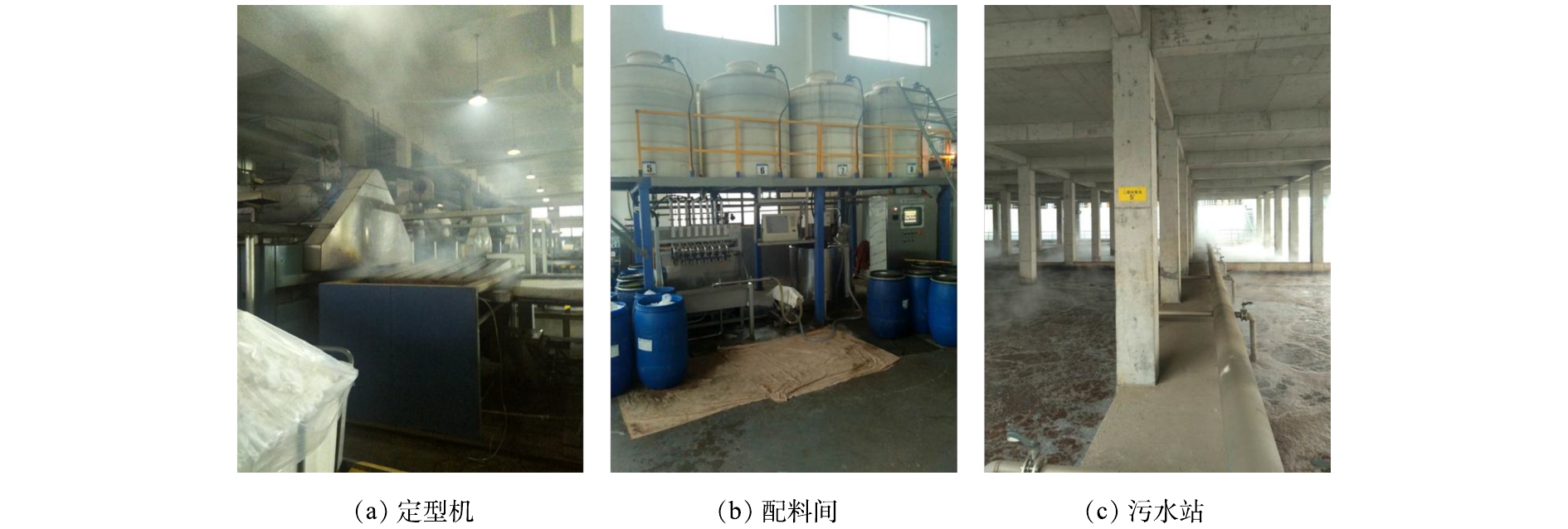
 下载:
下载:
